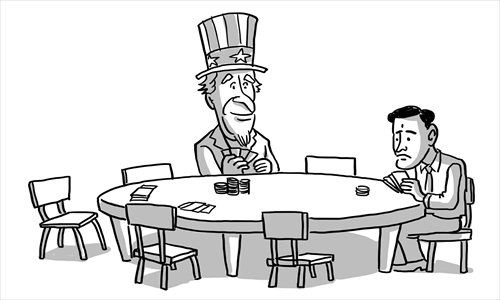A more open and inclusive TPP benefits all

Illustration: Liu Rui/GT
The origins of the Trans-Pacific Partnership (TPP) may be traced back to 2005, when four countries from around the Pacific Ocean - Chile, Singapore, Brunei and New Zealand - forged the Trans-Pacific Strategic Economic Partnership (TPSEP), essentially a free trade agreement (FTA) among themselves.
With more and more countries from around the Pacific region expressing interest, the TPSEP gradually evolved into the TPP.
After the US decided in 2008 to enter into negotiations, the previously low-key TPP assumed a vigorous and ambitious phase, becoming a "free-trade-plus" agreement aiming to not only reduce trade barriers among signatories, as is wont for traditional FTAs, but also comprehensively integrate the signatory economies.
This is of great significance to the world economy, as a successfully concluded TPP - including Japan which has just entered into negotiations - would straddle a combined 40 percent of the world's GDP and about a third of total global trade volume.
It is hoped that reduced tariffs and non-tariff barriers will further facilitate trade among these substantial economies, "value-adding" them in the process and thus stimulating a world economy still reeling from a massive slump since 2008.
These are lofty enough goals especially in times of economic distress.
The devil, however, is in the details, or more specifically, the "free-trade-plus" elements in the TPP.
The TPP also encompasses other socioeconomic matters such as intellectual property rights, labor policy, health and sanitary policy, government procurement, among others.
But the concerns above perhaps still pale in the face of two major drawbacks. First is the nefarious secrecy that is shrouding the entire negotiation process, the most recent round of which was just concluded in Kota Kinabalu, Malaysia.
Confidentiality is admittedly crucial in traditional FTA negotiations. But the TPP goes above and beyond a traditional FTA.
The most affected parties - the citizens of the various potential signatories - are effectively excluded from the intricacies of an agreement that goes far beyond producing or purchasing cheaper goods and services.
In more developed economies such as the US, citizens and public interest groups are disturbed by the potential lowering of labor and health standards.
In developing countries too, individuals and groups are anxious that they do not become dumping grounds for low-tech goods and services from more advanced signatories, thus decimating their own competitiveness along the way.
Second is the widely held perception that the TPP has, perhaps unintentionally, become dominated by the US, with it laying down most of the terms of negotiations.
This could scare away potential signatories uncomfortable with an already strategically, and now perhaps once again economically, dominant US in the new world order.
Even in the US, where delicate constitutional arrangements require the president to work closely with Congress in negotiating FTAs, more than a few lawmakers are troubled by the Obama administration's seeming reluctance to bring the legislative branch into the TPP loop.
With this in mind, Japan's entry into the negotiations has been welcomed by many as this will hopefully provide a counterweight to the seemingly US-oriented negotiation process and eventual agreement.
South Korea was invited to join but has since declined. China merely watches the TPP negotiations with interests. These two East Asian economic powerhouses arguably should formally enter into TPP negotiations as soon as possible for three reasons.
First, the TPP in conjunction with the newly started Transatlantic Trade and Investment Partnership between the EU and the US would account for about two-thirds of both the world's GDP and trade volume, so China and South Korea cannot afford to shut themselves off from this mainstream movement in the global economy.
Second, the entry of China and Korea into negotiations now will provide more counterweights to the TPP terms and conditions, whereas if they only accede to the TPP later, then they will have to accept most of the terms laid down by the US and Japan.
Third and most importantly, South Korea and China could shrewdly make use of their TPP entries to upgrade and add value to their already powerful economic locomotive so as to achieve even further socioeconomic milestones.
A more balanced and less secretive TPP will not only comfort many potential signatories, but will also truly attain its goal of ushering in a more vibrant world economy.
The author is a senior fellow with the S. Rajaratnam School of International Studies, Nanyang Technological University, Singapore. opinion@globaltimes.com.cn